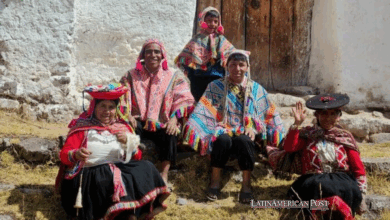Ancient Mummies of Children Unearthed in Lima, A Glimpse into Peru’s Enigmatic Ychsma Culture
In an astonishing archaeological discovery, researchers in Peru have unearthed the well-preserved remains of four child mummies, believed to be over a millennium old.

11/20/2023.- Photo provided by the Ministry of Culture of Peru of archaeologists working with mummies found in a pre-Hispanic pyramid in Lima (Peru). EFE/ Peruvian Ministry of Culture
Latin American Post Staff
Escucha este artículo
Leer en español: Antiguas momias de niños desenterradas en Lima, un vistazo a la enigmática cultura Ychsma del Perú
Found in what was once a sacred ceremonial space, now situated in one of Lima's oldest neighborhoods, these mummies shed light on the enigmatic Ychsma culture that thrived along Peru's central coast before the mighty Inca Empire's ascent..
Unveiling Lima's Ancient Secrets: A Treasure Trove of Ychsma Civilization
The excavation site in the heart of modern-day Lima has yielded a treasure trove of historical insights. Researchers uncovered the ancient mummies alongside the remains of an adult, all believed to hail from the Ychsma civilization. This culture predates the Inca Empire, an expansive and influential civilization that dominated much of the Andean region.
The Ychsma culture remains relatively enigmatic, with limited historical records to illuminate its practices and way of life. This archaeological find, therefore, assumes paramount significance in unraveling the mysteries of this ancient civilization.
The discovery offers a unique opportunity to study the burial customs, beliefs, and daily lives of the Ychsma people.
The remarkable find occurred at the base of a small hill, thought to have once concealed a temple of great significance.
Luis Takuda, an archaeologist based in Lima's Rimac district, explained that the temple likely dates back 3,500 years. "This whole area is a critical ceremonial chamber," Takuda emphasized. "The people who lived here during the Ychsma period still considered it a sacred space and therefore buried their dead here."
Astonishingly, the mummies unearthed in this sacred space retain traces of hair on their skulls, offering an intimate glimpse into the lives of these ancient inhabitants. Archaeologists discovered ceramic artifacts alongside the mummies, adding further historical richness to this extraordinary find.
Lima's Historical Layers: Bridging Ancient and Modern Worlds
Lima, a bustling metropolis with a population of approximately 10 million, is a city that straddles both the modern and ancient worlds. The capital boasts around 400 archaeological ruins, underscoring the depth of history beneath its contemporary surface.
While many of Peru's most significant archaeological sites are located outside Lima, such as the renowned Cusco, which served as the capital of the Inca Empire before its conquest by Spanish conquistadores in the 16th century, the recent discovery highlights that the city itself holds a wealth of historical treasures waiting to be unveiled.
This remarkable discovery adds to the mosaic of ancient civilizations that once flourished in Peru. The Ychsma culture, known for its distinctive architecture and artistic expressions, now finds its story further illuminated. These child mummies from the Ychsma culture provide a poignant reminder of the complex and rich tapestry of civilizations that once thrived in this region, offering a window into a world that existed long before our time.
Archaeological Insights: Piecing Together the Puzzle of History
Archaeological findings like these are invaluable for piecing together the puzzle of history. They provide insights into ancient cultures' daily life, religious beliefs, and burial practices. Moreover, the presence of hair on the mummies' skulls opens up possibilities for genetic and forensic analysis, potentially shedding light on the ancestral origins of the Ychsma people and their health.
Also read:Renaissance of Wisdom: The Florentine Codex Goes Digital
Preserving and studying these mummies and associated artifacts will be of paramount importance. The meticulous work of archaeologists and preservationists ensures that these discoveries continue to enrich our understanding of the past. It also underscores the need for responsible and sustainable archaeological practices to safeguard our shared heritage for future generations.
The recent discovery of child mummies from the Ychsma culture in Lima is a testament to the enduring allure of archaeology. It reminds us that, even in a modern metropolis, the echoes of ancient civilizations continue to resonate beneath our feet. These mummies are not just relics of the past; they are windows into the intricate tapestry of human history, inviting us to explore, learn, and marvel at their secrets.




